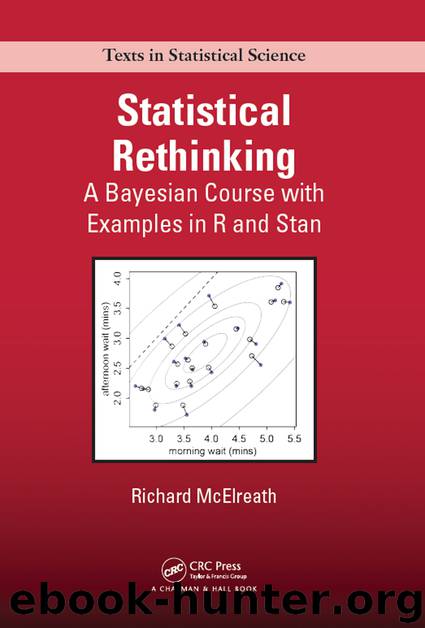Statistical Rethinking by Richard McElreath

Author:Richard McElreath
Language: eng
Format: epub
FIGURE 7.6. The other side of the interaction between ruggedness and continent. Blue points are nations with above-median ruggedness. Black points are below the median. Dashed black line: relationship between continent and log-GDP, for an imaginary nation with minimum observed ruggedness (0.003). Blue line: an imaginary nation with maximum observed ruggedness (6.2).
This perspective on the GDP and terrain ruggedness data is completely consistent with the previous perspective. It’s simultaneously true in these data (and with this model) that (1) the influence of ruggedness depends upon continent and (2) the influence of continent depends upon ruggedness. Indeed, something is gained by looking at the data in this symmetrical perspective. Just inspecting the first view of the interaction, back on page 220, it’s not obvious that African nations are on average nearly always worse off. It’s just at very high values of rugged that nations inside and outside of Africa have the same expected log-GDP. This second way of plotting the interaction makes this clearer.
7.3. Continuous interactions
The main point I want to convince the reader of is that interaction effects are difficult to interpret. They are nearly impossible to interpret, using only posterior means and standard deviations. We’ve already discussed two reasons for this (page 219). A third reason to be wary of using only tables of numbers to interpret interactions is that interactions among continuous variables are especially opaque. It’s one thing to make a slope conditional upon a category, as in the previous example of ruggedness and being in Africa. In such a context, the model reduces to estimating a different slope for each category. But it’s quite a lot harder to understand that a slope varies in a continuous fashion with a continuous variable. Interpretation is much harder in this case, even though the mathematics of the model are essentially the same as in the categorical case.
In pursuit of clarifying the construction and interpretation of CONTINUOUS INTERACTIONS among two or more continuous predictor variables, in this section I develop a simple regression example and show you a way to plot the two-way interaction between two continuous variables. The method I present for plotting this interaction is a triptych plot, a panel of three complementary figures that comprise a whole picture of the regression results. There’s nothing magic about having three figures—in other cases you might want more or less. Instead, the utility lies in making multiple figures that allow one to see how the interaction alters a slope, across changes in a chosen variable.
This example will also allow me to illustrate two benefits of CENTERING prediction variables. You met centering already (page 99). When a prediction variable is “centered,” it is just rescaled so that its mean is zero. Why would you ever do that to the data? There are two common benefits. First, centering the prediction variables can make it much easier to lean on the coefficients alone in understanding the model, especially when you want to compare the estimates from models with and without an interaction. Second, sometimes model fitting has a hard time with uncentered variables.
Download
This site does not store any files on its server. We only index and link to content provided by other sites. Please contact the content providers to delete copyright contents if any and email us, we'll remove relevant links or contents immediately.
| Biomathematics | Differential Equations |
| Game Theory | Graph Theory |
| Linear Programming | Probability & Statistics |
| Statistics | Stochastic Modeling |
| Vector Analysis |
Modelling of Convective Heat and Mass Transfer in Rotating Flows by Igor V. Shevchuk(6392)
Weapons of Math Destruction by Cathy O'Neil(6151)
Factfulness: Ten Reasons We're Wrong About the World – and Why Things Are Better Than You Think by Hans Rosling(4696)
Descartes' Error by Antonio Damasio(3232)
A Mind For Numbers: How to Excel at Math and Science (Even If You Flunked Algebra) by Barbara Oakley(3223)
Factfulness_Ten Reasons We're Wrong About the World_and Why Things Are Better Than You Think by Hans Rosling(3199)
TCP IP by Todd Lammle(3137)
Fooled by Randomness: The Hidden Role of Chance in Life and in the Markets by Nassim Nicholas Taleb(3049)
Applied Predictive Modeling by Max Kuhn & Kjell Johnson(3019)
The Tyranny of Metrics by Jerry Z. Muller(3005)
The Book of Numbers by Peter Bentley(2913)
The Great Unknown by Marcus du Sautoy(2649)
Once Upon an Algorithm by Martin Erwig(2601)
Easy Algebra Step-by-Step by Sandra Luna McCune(2585)
Lady Luck by Kristen Ashley(2535)
Practical Guide To Principal Component Methods in R (Multivariate Analysis Book 2) by Alboukadel Kassambara(2497)
Police Exams Prep 2018-2019 by Kaplan Test Prep(2488)
All Things Reconsidered by Bill Thompson III(2358)
Linear Time-Invariant Systems, Behaviors and Modules by Ulrich Oberst & Martin Scheicher & Ingrid Scheicher(2334)
